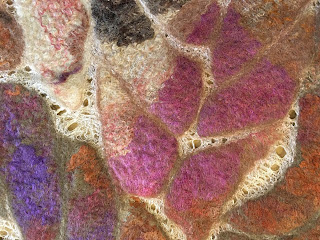Experimenting with Margilan
For several years, feltmakers around the globe have been working with some wonderful fabrics from Uzbekistan. I have really loved these materials, but it was getting very confusing for me to buy and use them, because every vendor seemed to have a different name for them. As an artist, I like to have some consistency with my materials so that I can design with them and be able to predict the results for the felts I am making.
Some background:
Most of these fabrics come from a city called Margilan (https://en.wikipedia.org/wiki/Margilan) in the Fergana Valley of Eastern Uzbekistan. According to the wikipedia article:
"The town is the location of Uzbekistan’s largest traditional silk factory, the Yodgorlik Silk Factory. Employing over 2,000 workers, everything is done in the traditional manner, for an annual output of some 250,000 square meters of highly premium silk cloth. The neighboring Margilan Silk Factory employs 15,000 workers using modern machinery, and produces some 22 million square meters per year. It is uncertain when the secrets of silk production came to the Fergana Valley, but certainly, Margilan has been active in the industry since ancient times"
Yodgorlik Silk Factory - https://orexca.com/yodgorlik_factory.shtml
https://www.advantour.com/uzbekistan/margilan/silk-factory.htm
I believe that the more modern factory is the one left from the Soviet era. I cannot confirm its name. I have also heard that weaving silk fabric is a cottage industry in the area, so some of these fabrics might be coming from home industry as well as the factories. This might explain why there are so many different widths, densities, and types of woven silk fabric.
Much of the silk that is woven here is a very dense, brightly patterned type of warp ikat satin weave that is used for garments and wall hangings. This fabric is called khan-atlas (Khan's Silk). You can see many examples of this fabric by Googling khan-atlas or look here on Etsy for SultanShop which has many examples for sale: https://www.etsy.com/sg-en/listing/640312017/vintage-handmade-100-silk-ikat-khan
Here is an example from their shop.
However, this fabric would be too dense for the lamination technique I and many other feltmakers like to use. This technique (also called nuno) is where layers of wool fiber are felted onto a layer of a thin fabric such as a gauze. The fabric adds stability to the felt so that the felter can lay out very thin layers of wool fiber and still have a strong cloth. The spaces between the warps and wefts of the cloth must be open enough that the wool fiber can travel through it as the fiber migrates in the process of becoming felt. When the fibers travel through the cloth, they capture it and it becomes entangled with the fiber on the surface of the felt.
But the silk weavers of Margilan also make a very open weave silk fabric that was originally used for helping preserve and repair antique icons and other type of art. The story is that a contemporary Russian feltmaker from Kazakhstan saw this fabric and realized its potential for use in feltmaking. (Edited note from Lena Archbold: "The felter's name is Elena Agapove and her business name is Lady Craft. https://www.livemaster.ru/ladycraft" )
This fabric became very popular with many different Russian feltmakers and eventually it made its way to the market place so that other feltmakers around the world could also use it. But the sheer silk Margilan silk fabrics that are sold are not consistent. Often they are just called Margilan or Uzbek silk gauze, but there are different densities available.
For several years, I had been using the Margilan on the surface of my laminated felts in order to add sheen because these silk fabrics are exceptionally shiny. Because I use a variety of fabrics on the surface of my felts, the variety of densities didn't frustrate me at that time. Then by coincidence, I took two online workshops and purchased an instructional video where the Margilan silk was used*. Because I was using even more of it and using it in different ways than I had previously, the inconsistencies in the product from various vendors was quite frustrating. So I decided to do some experiments and purchased the silk from different vendors to do some comparisons.
*The online classes were with Katia Mokeyeva (https://www.feuer-und-wasser.com/online-classes) The first was "Dramatic Surface and Fiber Bas-Relief" and the second was "Structural and Textural Surfaces for Fiber Artists". The video tutorial was from Maria Gladchenko (http://www.tvfelt.com/shop/artfelt/en/artfelt). It was titled "Art Felt Stole and Bolero".
Mosaic Experiments
I was able to ascertain that there are currently 4 types of Margilan silk available for feltmakers.
1. Sparse (also called rarefied) which is the most open weave and after felting it resembles a lacy textile. The holes are large enough that I would be reluctant to use this as a background for mosaic felting techniques on garments.
2. Scrim which is a little denser. It also opens up after felting into a lacy structure, but the holes are smaller than the sparse silk and the fabric seems to be more stable than the sparse. Update: When the Rarefied is from the Soviet Era factory in Margilan, it is like the scrim I have purchased in the USA on Etsy.
3. Gauze which resembles the Chinese silk gauze sold by various vendors such as Dharma Trading Company or Thai Silks. But the Margilan gauze has larger warps and wefts and it is much shinier than the Chinese gauze.
4. Excelsior which is a more densely woven fabric that resembles 5 mommee silk paj or habotai.
I used the techniques I learned from the video of Maria Gladchenko to make four mosaic felt samples, each one on one of the four Margilan types. With this method of felting, the artist first makes a decorated pre-felt. I used 19 micron merino wool and decorated the surfaces of the wool layers with viscose fiber. Then I cut up the pre-felts and spread them apart to put breaks between the designs. (Fractured Images) I put these cut up pre-felts onto a fabric base made from one of the types of Margilan silk fabric that I found.
1. Sparse
2. Scrim
3. Gauze
4. Excelsior
1. Sparse Fabric Study and Detail
Notice that the holes in the background are pretty large, up to the size of the fingernail on my little finger.
2. Scrim Study and Detail.
The detail shows that even though there are a few larger holes, most of them are smaller and the fabric would be more secure for wearables.
3. Gauze Study and Detail
This detail shows that there are much smaller holes.
4. Excelsior Study and Detail
This background is very dense but still flexible.
Here are some items I made using the Mosaic Felt technique with Margilan Scrim as a base:
Roses, a Wall Hanging with Detail, Pat Spark copyright 2019
1. Sparse (Rarefied)
RaisaFelt - www.etsy.com/shop/RaisaFelt
Living Felt - http://feltingsupplies.livingfelt.com/Margilan-Silk-Fabric--Rarefied-Uzbek-Silk-35_p_1310.html
SilkForFelting - https://www.etsy.com/shop/SilkForFelting
2. Scrim (Also called Rarefied when it comes from the Soviet Era Factory in Margilan.)
Katia Mokeyeva (Fabric I used in the Mosaic Felt Items above.) https://www.feuer-und-wasser.com/margilan-silk
Lena Archbold - https://www.lenaarchbold.co.uk/margilan-silk
3. Gauze
Living Felt -http://feltingsupplies.livingfelt.com/Silk-Gauze-Fabric--Uzbek-Silk-35_p_1311.html
Living Felt -http://feltingsupplies.livingfelt.com/Silk-Gauze-Fabric--Uzbek-Silk-35_p_1311.html
GaliBaba -https://www.etsy.com/shop/GaliBaba
4. Excelsior
Living Felt -http://feltingsupplies.livingfelt.com/Silk-Excelsior-Fabric--Uzbek-Silk-35-_p_1370.html
SilkForFelting - https://www.etsy.com/shop/SilkForFelting
Lena Archbold - https://www.lenaarchbold.co.uk/margilan-silk
Lena Archbold also has another type of Margilan - Organza. It is available here: https://www.lenaarchbold.co.uk/margilan-silk
Lena Archbold - https://www.lenaarchbold.co.uk/margilan-silk
Lena Archbold also has another type of Margilan - Organza. It is available here: https://www.lenaarchbold.co.uk/margilan-silk









.jpg)





















